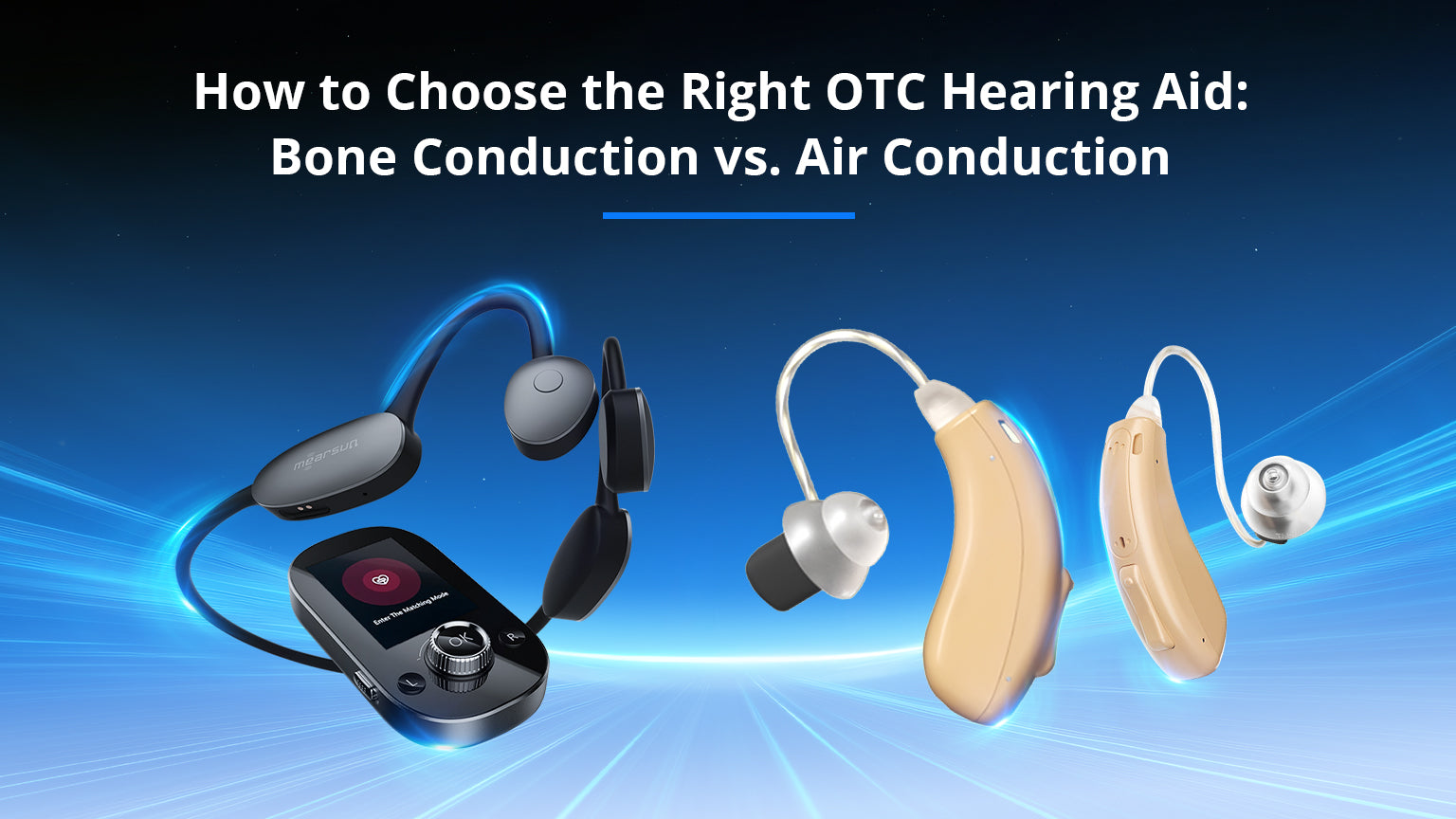In today’s world of hearing technology, over-the-counter (OTC) hearing aids are more accessible and affordable than ever. But with multiple options available, one key question stands out: Should you choose a bone conduction or air conduction hearing aid?
Understanding the difference between these two types is essential for finding the right fit for your hearing needs—and for your lifestyle.
Two Ways We Hear: Air vs. Bone Conduction
Air Conduction Hearing Aids
This is the most common type of hearing aid. These devices collect sound through a microphone, amplify it, and send it through your ear canal to vibrate the eardrum and middle ear bones, which then stimulate the inner ear (cochlea). This is the natural route of hearing and is suitable for most users.
Bone Conduction Hearing Aids
bypass the ear canal and middle ear entirely. Instead, they transmit sound as vibrations through the bones of the skull directly to the inner ear. These devices are typically worn behind the ear or integrated into glasses or a headband.
Who Should Use Bone Conduction Hearing Aids?
Bone conduction hearing aids are often the best—and sometimes the only—solution for people who cannot use traditional devices due to physical or medical conditions. You may benefit from bone conduction if you have:
-
Conductive Hearing Loss: If your hearing loss is caused by problems in the outer or middle ear, but your inner ear is still working well.
-
Chronic Ear Infections or Drainage: Conditions like chronic otitis media or eczema in the ear canal can make wearing in-ear devices painful or risky.
-
Ear Canal Blockage or Malformation: If you have a narrow, closed, or missing ear canal (e.g., atresia or microtia), bone conduction can bypass the obstruction.
-
Single-Sided Deafness (SSD): Bone conduction can transmit sound from the deaf side to the healthy ear.
-
Post-Surgical Conditions: After procedures like mastoidectomy, traditional air conduction hearing aids may no longer be suitable.
✅ Bone conduction hearing aids are ideal when air conduction is physically not an option.
Who Should Use Air Conduction Hearing Aids?
Air conduction hearing aids are the go-to solution for most people with sensorineural hearing loss or mixed hearing loss. They are highly customizable and come in a wide range of styles, including invisible-in-canal (IIC), in-the-ear (ITE), and behind-the-ear (BTE).
You may be a good candidate if you:
-
Have Sensorineural Hearing Loss: The most common form of permanent hearing loss caused by aging, noise exposure, or nerve damage.
-
Prefer Discreet Devices: Many air conduction models are nearly invisible and very lightweight.
-
Have Mild to Severe Hearing Loss: Advanced processing in today’s air conduction hearing aids delivers excellent sound quality across a wide frequency range.
-
Have No Chronic Ear Conditions: Air conduction devices work best in ears that are structurally normal and free of ongoing infection or irritation.
🎧 Air conduction hearing aids deliver natural, full-spectrum sound and are suitable for the majority of users.
Pros and Cons at a Glance
| Feature | Bone Conduction | Air Conduction |
|---|---|---|
| Best for | Conductive loss, SSD, ear malformations | Sensorineural loss, general use |
| Sound Route | Skips ear canal, vibrates skull | Travels through ear canal and middle ear |
| Comfort | No ear blockage, but may cause head pressure | In-ear fit may feel plugged or cause irritation |
| Visibility | Headband/glasses style, less discreet | Often small and nearly invisible |
| Sound Quality | Clear speech, limited bass | Full-range sound, better for music and high frequencies |
| Infection Risk | Low | Slightly higher, especially with ear canal issues |
The Rise of Discreet Bone Conduction Technology
Bone conduction devices used to be bulky and obvious. Not anymore. New models—like glasses-style bone conduction hearing aids—look like regular eyewear and are easy to wear all day. These are perfect for users who want the benefits of bone conduction without drawing attention.
Mearsun’s latest bone conduction hearing aids offer sleek design, high-fidelity sound, and medical-grade vibration technology—helping users stay active and connected, even with challenging ear conditions.
How to Decide? Start With a Hearing Test
Before choosing any OTC hearing aid, it’s important to:
-
Understand Your Type of Hearing Loss: Is it sensorineural, conductive, or mixed?
-
Evaluate Ear Anatomy & Health: Do you have chronic infections or structural ear differences?
-
Get a Bone vs. Air Conduction Threshold Test: This helps determine which technology your ears respond to best.



Share:
Mearsun Hearing Aids—Revitalize Your Hearing!
Hear Clearly, Stay Aware: Why Bone Conduction OTC Hearing Aids Are Different